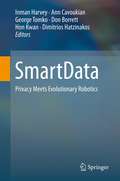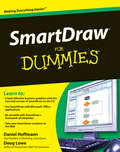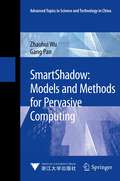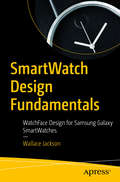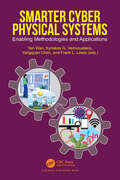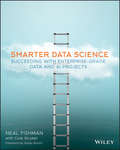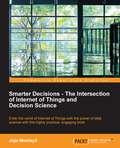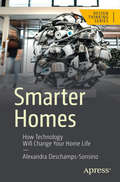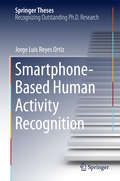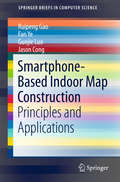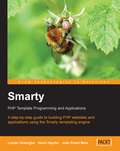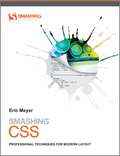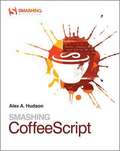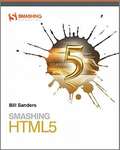- Table View
- List View
Smart and Sustainable Technology for Resilient Cities and Communities (Advances in Sustainability Science and Technology)
by Lakhmi C. Jain Robert J. Howlett John R. Littlewood Marius M. BalasThis book is a collection of extended versions of papers presented at the KES Covid-19 Challenge international summit. The book focusses on technological, economic, and social developments to combat the effects of global and local disasters as well as the ways in which the recovery from Covid can be used to build more resilient and sustainable communities, industry, and improve the environment. It also discusses the global challenges of human-influenced climate change. There are chapters on making cities and communities more resilient through energy self-sufficiency, food production, resilient housing and buildings, human health and intelligent systems e.g. for forecasting and prediction.
SmartData
by George Tomko Hon Kwan Inman Harvey Don Borrett Ann Cavoukian Dimitrios HatzinakosSmartData empowers personal data by wrapping it in a cloak of intelligence such that it now becomes the individual's virtual proxy in cyberspace. No longer will personal data be shared or stored in the cloud as merely data, encrypted or otherwise; it will now be stored and shared as a constituent of the binary string specifying the entire SmartData agent. This agent proactively builds-in privacy, security and user preferences, right from the outset, not as an afterthought. SmartData: Privacy Meets Evolutionary Robotics includes the advances made in the technology of simulating virtual worlds, together with the ideas emerging from fields of evolutionary robotics and embodied cognition within a framework of dynamical systems as an approach toward this ultimate goal. The book brings together top researchers in the field and addresses current personal data privacy challenges in the online-world.
SmartDraw For Dummies
by Doug Lowe By Daniel HoffmannDiagrams, organizational charts, flowcharts, even floor plans - they're all types of business graphics. Only one tool does 'em all: SmartDraw. SmartDraw For Dummies shows you how this business graphics software helps you make boring presentations exciting and how to create graphics that can help you sell, manage, inform, motivate, and more. You'll learn how to set up the program, navigate its somewhat unique interface, and work with SmartDraw's thousands of templates. You don't need artistic talent, just this handy guide and the extended, fully functional trial version of SmartDraw that's on the bonus CD! Use SmartDraw templates to create org charts, flowcharts, express charts, mind maps, Live Maps, and more Dress up your graphics with color, effects, and design themes Learn to integrate your graphics into Microsoft Office applications and animate graphics for cool PowerPoint presentations Explore SmartDraw diagrams for Web pages and e-mail newsletters Import SmartDraw graphics into Word and Excel documents Take advantage of extra software and additional templates, sample drawings and flowcharts, image editing tools, maps, and flyers on the CD You'll also find graphics guidelines to help you create more effective charts and presentations, plus tips on using color and images to your advantage. Written by a Microsoft PowerPoint MVP and a SmartDraw vice president, SmartDraw For Dummies helps you banish boring charts forever! Note: CD-ROM/DVD and other supplementary materials are not included as part of eBook file.
SmartSchool - Die Schule von morgen
by Detlef SteppuhnDer technologische Wandel gewinnt rasant an Tempo – alle Schulen müssen sich dieser Herausforderung zeitnah stellen. Dieses Sachbuch erläutert, welche Technologien warum in Schulen zum Einsatz kommen müssen und welche besonderen Fortbildungs- und Supportkonzepte sie wirklich benötigen, wozu SmartTeams gebraucht werden und welche Bedeutung Robotik, KI, Virtual Reality, eSports und Wettbewerbe für den Unterricht haben. Alle Beteiligten erhalten viele Anregungen, Tipps, Ideen und Beispiele für den erfolgreichen Weg zu einer – auch, wenn viele das Wort noch scheuen – SmartSchool. Kritisch hinterfragen die Autoren, warum es (noch) keine guten digitalen Unterrichtsmaterialien gibt und warum Schulen und Schulträger intensiver zusammenarbeiten müssen. Denn SmartSchools sind die Schulen von morgen! - Mit Online-Zusatzmaterialien.
SmartShadow: Models and Methods for Pervasive Computing
by Gang Pan Zhaohui WuSmartShadow: Models and Methods for Pervasive Computing offers a new perspective on pervasive computing with SmartShadow, which is designed to model a user as a personality "shadow" and to model pervasive computing environments as user-centric dynamic virtual personal spaces. Just like human beings' shadows in the physical world, it follows people wherever they go, providing them with pervasive services. The model, methods, and software infrastructure for SmartShadow are presented and an application for smart cars is also introduced. The book can serve as a valuable reference work for researchers and graduate students in the field of pervasive/ubiquitous computing. Zhaohui Wu is a Professor at Zhejiang University, Hangzhou, China. Gang Pan is a Professor at the same institute.
SmartWatch Design Fundamentals: WatchFace Design for Samsung Galaxy SmartWatches
by Wallace JacksonGain concepts central to smartwatch design, editing and animation correction using the popular open source Galaxy Watch Designer software package. This visual guide builds upon the essential concepts of smartwatch design, decoration, digital imaging, animation, function integration, and visual effects, and gets more advanced as chapters progress, covering which digital new media file formats (JPEG, PNG, GIF, etc.) are best for use with smartwatch design.Smart Watch Design Fundamentals also covers key factors in the data footprint optimization work process, designing and optimizing animation assets, and why these optimizations are important. Additionally, the book covers other advanced topics such as how to provide free smartwatch faces for the first few days on the smartwatch store, and how to post watchface designs for sale in the store.What You'll Learn:Create a smartwatch design and visual effects pipelineGain knowledge of the concepts behind smartwatch designWork with resolution, aspect ratio, animation, and color depthUse smartwatch design components such as ticks, numerals, feature markers, dates, etc. Optimizing digital image asset data footprint to create small smartwatch design file sizesWho This Book Is For:This book is primarily for smart watch and fashion designers.
Smarte Services mit künstlicher Intelligenz: Best Practices der Transformation zum digitalisierten, datengetriebenen Unternehmen
by Egmont FothIn diesem Buch erfährt der Leser, wie smarte Services mit künstlicher Intelligenz realisierbar sind und wie eine digitale Transformation gelingt, mit der sich die Kundenorientierung, Wettbewerbsfähigkeit, Widerstandsfähigkeit, Agilität und Nachhaltigkeit von Unternehmen verbessern lässt. Was sind smarte Services und wie sehen sie in der Praxis aus? Was beinhalten die dafür erforderlichen Komponenten Internet of Things, Data Lake und Advanced Analytics? Wofür lässt sich die künstliche Intelligenz einsetzen und wie erfolgt das in der Praxis? Wie entsteht Digital Trust? Wie lässt sich der digitale Reifegrad von Unternehmen ermitteln? Welches Vorgehen hat sich für die digitale Transformation in der Praxis bewährt? Wofür wird ein digitales Ecosystem benötigt und wie kann es aussehen? Was wird unter „New Work“ verstanden? Wie arbeiten datengetriebene Unternehmen und welche Vorteile hat das? Was ist ein Digital Use Case? Wie läuft ein Use-Case-Entwicklungs-Workshop ab? Wie lässt sich ein Digital Use Case strukturiert beschreiben? Welche interessanten, innovativen Beispiele für Digital Use Cases gibt es? Wie erfolgt ein Proof of Concept? Wie lassen sich die Kernprozesse Order to Cash (O2C), Procure to Pay (P2P), Design to Operate (D2O), Recruit to Retire (R2R) und Awareness to Advocacy (A2A) digitalisieren? Welche neuen digitalen Technologien und in ihrem Zusammenhang angewandte Verfahren existieren?
Smarter Clicking: School Technology Policies That Work!
by Christopher W. WellsDevelop safe technology practices that support learning and protect your school, staff, and students! Designed to support appropriate use of technology for teaching and learning, this comprehensive guide gives school leaders a clear road map for creating, implementing, and maintaining effective instructional technology policies. In jargon-free terms, Wells explains legal considerations and offers case studies and concrete strategies to help educators: Evaluate their school’s needs Involve stakeholders in a collaborative effort Protect student and staff privacy Respond to challenges presented by social networking and emerging technologies Avoid inappropriate, costly use of technology Develop acceptable use policies
Smarter Cyber Physical Systems: Enabling Methodologies and Applications
by Yangquan Chen Frank L. Lewis Kyriakos G. Vamvoudakis Yan WanCyber-Physical Systems (CPS) is featured by the tight integration of cyber and physical components. CPS has made major advances with a broad societal impact. Now in the era of Industry Revolution 4.0, CPS is considered as an enabling technology. Combined with autonomy, big data, machine learning and internet of things, CPS empowers systems with greater intelligence to address uncertainties, unknowns, attacks, and unexpected events.This book highlights the latest advances and explores the new trends in the design and implementation of smarter Cyber-Physical systems (CPS). It introduces integrated model-based and data-driven solutions for CPS that demonstrate features including both adaptability and interpretability. Key topics covered include reinforcement learning, digital twin and large-scale networks. The book then presents the latest codesign techniques that address practical computation, networking, control, and physical constraints. It examines important issues related to human CPS, safety, resilience and privacy. The chapters feature the tight integration of theory and practice, including problems motivated from applications, fundamental research development that are generally applicable, and implementation in real system applications. A wide range of CPS applications are covered, including robotics, autonomous driving, unmanned aerial vehicles and smart cities.
Smarter Data Science: Succeeding with Enterprise-Grade Data and AI Projects
by Cole Stryker Neal FishmanOrganizations can make data science a repeatable, predictable tool, which business professionals use to get more value from their data Enterprise data and AI projects are often scattershot, underbaked, siloed, and not adaptable to predictable business changes. As a result, the vast majority fail. These expensive quagmires can be avoided, and this book explains precisely how. Data science is emerging as a hands-on tool for not just data scientists, but business professionals as well. Managers, directors, IT leaders, and analysts must expand their use of data science capabilities for the organization to stay competitive. Smarter Data Science helps them achieve their enterprise-grade data projects and AI goals. It serves as a guide to building a robust and comprehensive information architecture program that enables sustainable and scalable AI deployments. When an organization manages its data effectively, its data science program becomes a fully scalable function that’s both prescriptive and repeatable. With an understanding of data science principles, practitioners are also empowered to lead their organizations in establishing and deploying viable AI. They employ the tools of machine learning, deep learning, and AI to extract greater value from data for the benefit of the enterprise. By following a ladder framework that promotes prescriptive capabilities, organizations can make data science accessible to a range of team members, democratizing data science throughout the organization. Companies that collect, organize, and analyze data can move forward to additional data science achievements: Improving time-to-value with infused AI models for common use cases Optimizing knowledge work and business processes Utilizing AI-based business intelligence and data visualization Establishing a data topology to support general or highly specialized needs Successfully completing AI projects in a predictable manner Coordinating the use of AI from any compute node. From inner edges to outer edges: cloud, fog, and mist computing When they climb the ladder presented in this book, businesspeople and data scientists alike will be able to improve and foster repeatable capabilities. They will have the knowledge to maximize their AI and data assets for the benefit of their organizations.
Smarter Decisions – The Intersection of Internet of Things and Decision Science
by Jojo MoolayilEnter the world of Internet of Things with the power of data science with this highly practical, engaging book About This Book * Explore real-world use cases from the Internet of Things (IoT) domain using decision science with this easy-to-follow, practical book * Learn to make smarter decisions on top of your IoT solutions so that your IoT is smart in a real sense * This highly practical, example-rich guide fills the gap between your knowledge of data science and IoT Who This Book Is For If you have a basic programming experience with R and want to solve business use cases in IoT using decision science then this book is for you. Even if your're a non-technical manager anchoring IoT projects, you can skip the code and still benefit from the book. What You Will Learn * Explore decision science with respect to IoT * Get to know the end to end analytics stack - Descriptive + Inquisitive + Predictive + Prescriptive * Solve problems in IoT connected assets and connected operations * Design and solve real-life IoT business use cases using cutting edge machine learning techniques * Synthesize and assimilate results to form the perfect story for a business * Master the art of problem solving when IoT meets decision science using a variety of statistical and machine learning techniques along with hands on tasks in R In Detail With an increasing number of devices getting connected to the Internet, massive amounts of data are being generated that can be used for analysis. This book helps you to understand Internet of Things in depth and decision science, and solve business use cases. With IoT, the frequency and impact of the problem is huge. Addressing a problem with such a huge impact requires a very structured approach. The entire journey of addressing the problem by defining it, designing the solution, and executing it using decision science is articulated in this book through engaging and easy-to-understand business use cases. You will get a detailed understanding of IoT, decision science, and the art of solving a business problem in IoT through decision science. By the end of this book, you'll have an understanding of the complex aspects of decision making in IoT and will be able to take that knowledge with you onto whatever project calls for it Style and approach This scenario-based tutorial approaches the topic systematically, allowing you to build upon what you learned in previous chapters.
Smarter Homes: How Technology Will Change Your Home Life
by Alexandra Deschamps-SonsinoExamine the history of smart homes, how technology shapes our lives, and ways you can think about the home when developing new products. This book presents the opportunities in the homespace that will come from understanding the history and multiple players that have contributed to the development of the home in general. You'll start by breaking down the historical, societal and political context for the changes in focus of that ‘smartness’ from affordability, efficiency, convenience to recently experimentation. The second half of the book then reviews what current developments tell us about what our homes will look like in the next 10 years through the lens of spaces, services, appliances and behaviours in our homes. Over the past 100 years, the home has been a battleground for ideas of future living. Fueled by the electrification of cities, the move from the country to cities, post-war recovery and the development of the internet, the way we live at home (alone or with others) has changed beyond recognition. Science fiction writing, the entertainment industry, art, and modern interior design and architecture movements have also contributed to defining our aspirations around a future and now more present and possible ‘smart’ home. Smarter Homes looks at the many new and innovative products that are being developed in the consumer and industrial spaces with a copy-paste mindset based on following larger businesses, such as Amazon, Google and Apple. What You'll LearnUnderstand the historical context for current smart home productsReview the social aspect of home product developmentDiscover new home technologies being developed and which ones are available nowTrack the industry behaviors being leveraged and how they may affect longer term market trends for consumer productsWho This Book Is ForEveryone working in product design and development, in R&D or in trends research, as well as those interested in the IoT for the home. This book will also give product business owners ideas about what has been done before and and avenues for future development.
Smartphone Communication: Interactions in the App Ecosystem (Routledge Studies in New Media and Cyberculture)
by Francisco YusThis book offers a unique model for understanding the cognitive underpinnings, interactions and discursive effects of our evolving use of smartphones in everyday app-mediated communication, from text messages and GIFs to images, video and social media apps. Adopting a cyberpragmatics framework, grounded in cognitive pragmatics and relevance theory, it gives attention to how both the particular interfaces of different apps and users’ personal attributes influence the contexts and uses of smartphone communication. The communication of emotions – in addition to primarily linguistic content – is foregrounded as an essential element of the kinds of ever-present paralinguistic and phatic communication that characterises our exchange of memes, GIFs, "likes," and image- and video-based content. Insights from related disciplines such as media studies and sociology are incorporated as the author unpacks the timeliest questions of our digitally mediated age. Aimed primarily at scholars and graduate students of communication, linguistics, pragmatics, media studies, and sociology of mass media, Smartphone Communication traffics in topics that will likewise engage upper-level undergraduate students.
Smartphone Energy Consumption
by Sasu Tarkoma Matti Siekkinen Eemil Lagerspetz Yu XiaoWith an ever-increasing number of applications available for mobile devices, battery life is becoming a critical factor in user satisfaction. This practical guide provides you with the key measurement, modeling, and analytical tools needed to optimize battery life by developing energy-aware and energy-efficient systems and applications. As well as the necessary theoretical background and results of the field, this hands-on book also provides real-world examples, practical guidance on assessing and optimizing energy consumption, and details of prototypes and possible future trends. Uniquely, you will learn about energy optimization of both hardware and software in one book, enabling you to get the most from the available battery power. Covering experimental system design and implementation, the book supports assignment-based courses with a laboratory component, making it an ideal textbook for graduate students. It is also a perfect guidebook for software engineers and systems architects working in industry.
Smartphone Safety
by Eric MintonSmartphones offer convenience and fun, but it is important to use them safely. This title points out phone features that owners can use to make their smartphones more secure. It discusses how to safely find, download, and use apps. The connection between smartphones and cyberbullying is addressed. Information about what to do if you lose your phone or need to get rid of an old phone is included, too.
Smartphone-Based Human Activity Recognition
by Jorge Luis Reyes OrtizThe book reports on the author's original work to address the use of today's state-of-the-art smartphones for human physical activity recognition. By exploiting the sensing, computing and communication capabilities currently available in these devices, the author developed a novel smartphone-based activity-recognition system, which takes into consideration all aspects of online human activity recognition, from experimental data collection, to machine learning algorithms and hardware implementation. The book also discusses and describes solutions to some of the challenges that arose during the development of this approach, such as real-time operation, high accuracy, low battery consumption and unobtrusiveness. It clearly shows that it is possible to perform real-time recognition of activities with high accuracy using current smartphone technologies. As well as a detailed description of the methods, this book also provides readers with a comprehensive review of the fundamental concepts in human activity recognition. It also gives an accurate analysis of the most influential works in the field and discusses them in detail. This thesis was supervised by both the Universitat Politècnica de Catalunya (primary institution) and University of Genoa (secondary institution) as part of the Erasmus Mundus Joint Doctorate in Interactive and Cognitive Environments.
Smartphone-Based Indoor Map Construction: Principles And Applications (SpringerBriefs in Computer Science)
by Ruipeng Gao Fan Ye Guojie Luo Jason CongThis book focuses on ubiquitous indoor localization services, specifically addressing the issue of floor plans. It combines computer vision algorithms and mobile techniques to reconstruct complete and accurate floor plans to provide better location-based services for both humans and vehicles via commodity smartphones in indoor environments (e.g., a multi-layer shopping mall with underground parking structures). After a comprehensive review of scene reconstruction methods, it offers accurate geometric information for each landmark from images and acoustics, and derives the spatial relationships of the landmarks and rough sketches of accessible areas with inertial and WiFi data to reduce computing overheads. It then presents the authors’ recent findings in detail, including the optimization and probabilistic formulations for more solid foundations and better robustness to combat errors, several new approaches to promote the current sporadic availability of indoor location-based services, and a holistic solution for floor plan reconstruction, indoor localization, tracking, and navigation. The novel approaches presented are designed for different types of indoor environments (e.g., shopping malls, office buildings and labs) and different users. A valuable resource for researchers and those in start-ups working in the field, it also provides supplementary material for students with mobile computing and networking backgrounds.
Smartphones as Mobile Minilabs in Physics: Edited Volume Featuring more than 70 Examples from 10 Years The Physics Teacher-column iPhysicsLabs
by Jochen Kuhn Patrik VogtThis book presents more than 70 physics experiments from iPhysicsLabs-column of the Journal The Physics Teacher. The articles are aimed at physics lecturers, trainee teachers and teachers who want to take their classes to the next level using digital devices. The experiments can easily be performed and analyzed using smartphones or tablets. The topics span from mechanics, optics, thermodynamics, astrophysics and astronomy to acoustics, electrodynamics and electronics.Authors worldwide have contributed to this series of articles. To celebrate the 10th anniversary of iPhysicsLabs, Jochen Kuhn and Patrik Vogt have collected more than 70 most popular and interesting articles for this book.
Smartphones, Current Events and Mobile Information Behavior: Consuming, Reacting, Sharing, and Connecting through News
by Kyong Eun Oh Rong TangSmartphones and Information on Current Events provides unprecedented insights into young people’s news consumption patterns and the ecology of mobile news. Advancing our knowledge of mobile behaviour, the book also highlights the ways in which mobile news impacts the lives of the general public. Using a multi-faceted research model on mobile news consumption behaviour, Oh and Tang examined a wide spectrum of mobile news consumption activities, outlined the key characteristics of mobile news, as well as captured users’ near real-time evaluation of and emotional reactions to news stories. The book also shows that the process of using smartphones to receive, read, find, share, and store news stories has resulted in new behavioural patterns that enable people to consume news in a multifaceted way. Analyzing the extent and various methods of mobile news sharing can, Oh and Tang argue, help us understand how such exchanges reshape contemporary society. Demonstrating that mobile news consumption is now an integral part of people’s daily lives, the book clearly shows that its impact on people’s day-to-day activities, and their political and social lives, cannot be underestimated. Smartphones and Information on Current Events will be useful to scholars, students, and practitioners who are studying library and information science, journalism and media, digital communication, user behaviour, information technology, human-computer interaction, marketing, political science, psychology, and sociology.
Smarty PHP Template Programming and Applications
by Joao Prado Maia Hasin HayderUsing a step-by-step approach based on realistic examples, the expert authors show you how to use Smarty in your own PHP development. This book is written for PHP developers who want to use Smarty templates in their development, and for designers who are working with PHP developers who are using Smarty.
Smasher
by Scott BlyIn this riveting suspense thriller, two children race the clock to stop a futuristic murderer and his plan to enslave the world. In thirty days, a cold-hearted corporate tycoon will unleash a deadly biological computer virus on the entire world. As the public eagerly awaits his invention that promises ultimate relaxation, harmony, and community, the evil big-business sorcerer plans to put an end to freedom. Can he be stopped? The world's only hope is if Charlie, a math genius with otherworldly skills, and Geneva, a robotic girl from the future, can team up to track down some very dark secrets. With a method that uses atomic particles, Geneva and Charlie use "Smasher" to break through the walls of time. They travel to find an unlikely solution. But will it work? Fresh, unique, and gripping, this page-turner also celebrates the power of love, hope, and friendship as it also raises provocative questions about technology, progress, and the nature of persecution.
Smashing Android UI
by Juhani LehtimakiDesigners and developers, create smashing apps for Android devicesIf you're developing applications for Android smartphones and tablets, you know it isn't enough just to create the app. The application has to be intuitive, well laid out, and easy to use. Smashing Android UI shows you just how to do that. Starting with basic components, this practical, full-color book shows you how to create scalable layouts, make use of adaptive layouts and fragments, follow Android design best practices, and design sleek, intuitive user interfaces using Android UI design patterns.One of the newest guides in the terrific Smashing Magazine book series, this book takes you beyond the basics with expert techniques and innovative ideas. Learn smart solutions that will help you avoid pitfalls while building apps that can scale up to a multitude of possible Android device-and-browser combinations.Teaches practical techniques for developing and designing applications that work on all Android phones and tablets Helps developers who have Android experience, but not necessarily design experience, as well as designers who want to follow Android design best practices and patterns Starts with how to use simple components and then moves on to building scalable layouts Covers adaptive layouts and fragments, responsive design, and how to design user interfaces using Android UI design patternsSmashing Android UI: Responsive Android UI and Design Patterns for Phones and Tablets helps you create apps for the hottest thing in technology--Android devices!
Smashing CSS
by Eric MeyerPROFESSIONAL TECHNIQUES FOR MODERN LAYOUTSmashing CSS takes you well beyond the basics, covering not only the finer points of layout and effects, but introduces you to the future with HTML5 and CSS3. Very few in the industry can show you the ins and outs of CSS like Eric Meyer and inside Smashing CSS Eric provides techniques that are thorough, utterly useful, and universally applicable in the real world. From choosing the right tools, to CSS effects and CSS3 techniques with jQuery, Smashing CSS is the practical guide to building modern web layouts.With Smashing CSS you will learn how to:Throw elements offscreen/hide themCreate body/HTML backgrounds in XHTMLUsemore than 15 layout techniques including clearfix, two/three simple columns, faux columns, One True Layout, Holy Grail, em-based layout, fluid grids, sticky footers, and moreUse a variety of CSS effects including CSS popups, boxpunching, rounded corners, CSS sprites, Sliding Doors, Liquid Bleach, ragged floats, and moreApply CSS table styling including using thead, tfoot, and tbody, row headers, column-oriented styling (classes); styling data tables with jQuery, tables to graphs, tables to maps; and moreUse CSS3 elements including rounded corners, multiple backgrounds, RGBA, using jQuery to do CSS3 selections and so much more.Eric Meyer is an internationally recognized expert on the subjects of HTML, CSS, and Web standards, and has been working on the Web since 1993. Smashing CSS is for developers who already have some experience with CSS and JavaScript and are ready for more advanced techniques.Smashing Magazine (smashingmagazine.com) is one of the world's most popular web design sites. True to the Smashing mission, the Smashing Magazine book series delivers useful and innovative information to Web designers and developers.
Smashing CoffeeScript
by Alex HudsonBrew the perfect code with CoffeeScriptIf you're familiar with JavaScript and the often-frustrating process of creating complex applications, a nice cup of CoffeeScript can help. CoffeeScript is a programming language that compiles into JavaScript and simplifies the entire development process. Now you can tap the full power of CoffeeScript with Smashing CoffeeScript. This full-color, practical book explains CoffeeScript language, syntax, and processes, and will soon have you producing concise and quality code. Ultimately, you'll create RIAs and mobile apps faster, with less hassle.Gets developers up and running on CoffeeScript, a programming language that compiles into JavaScript and simplifies the process of building softwareHelps you produce better JavaScript and more quicklyIntroduces the language, syntax, and processes of CoffeeScriptCovers the development of both mobile and rich internet appsExplores the HTML5 feature set, real-time communication, and using CoffeeScript within node.js projectsDevelopers, blend some better JavaScript with CoffeeScript and Smashing CoffeeScript.
Smashing HTML5
by Bill SandersWelcome to HTML5 - the future of the WebHTML5 is packed with great new features, including new content-specific elements, audio and video playback, canvas for drawing, and many others. But where to begin? With Smashing HTML5, you have everything you need to get up and running quickly.Bill Sanders is a professional Web developer, information and interface designer, and instructor. His expertise and knowledge shared throughout Smashing HTML5 will help fast-track you toward building next-generation Web sites.Smashing HTML5 provides comprehensive coverage - from how to get started with HTML5 to optimizing media on the Web. You will learn how to use text, graphics, audio, video, and navigation in HTML5 Web pages running in compatible browsers.You will also learn how to:Work with HTML5 tagsDesign page structureMake site navigation easy for your audienceIntegrate media including video into HTML5 pagesHarness the power of the HTML5 canvasUse HTML 5 formsCreate interactivity, store information, and much moreSmashing HTML5 is an essential read for Web designers and developers looking to transition to HTML5. With this book, you'll be able to create Web pages that not only look great, but also take advantage of the new features HTML5 has to offer.

